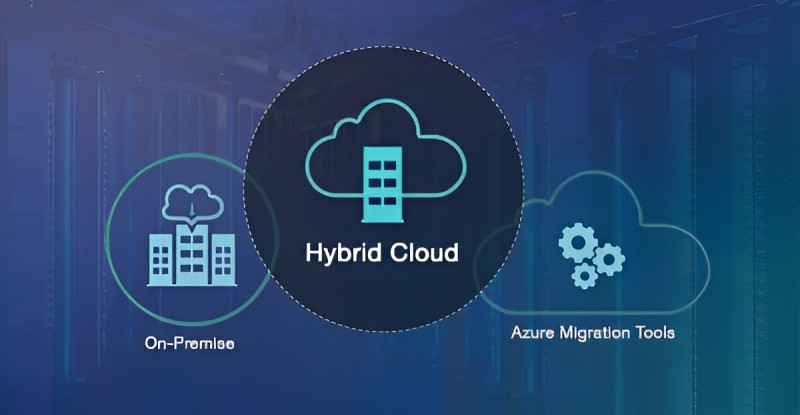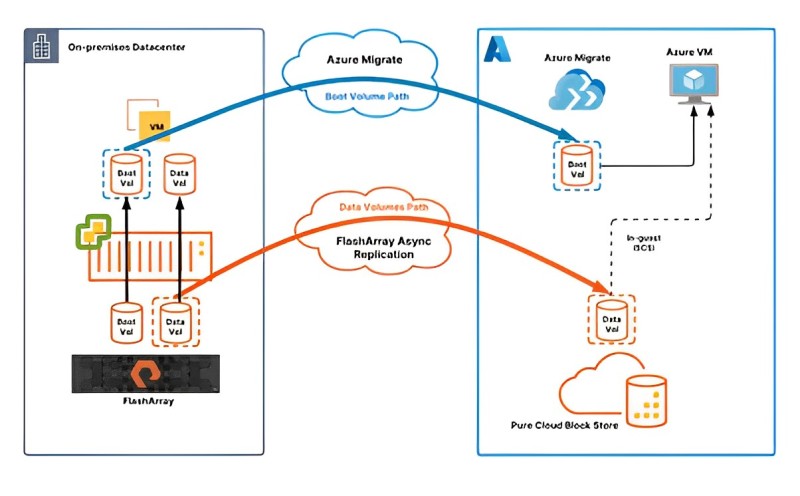
Image source: https://www.saviantconsulting.com/blog/azure-migration-tools-for-hybrid-cloud.aspx
Within the realm of productivity tools, azure cloud migration tools are among the most beneficial and widespread technologies available in the contemporary era. Users can migrate files, folders, and even whole directories in a time-efficient way both locally and remotely using these capabilities.
Regardless of whether the data transfer is being executed as a result of preservation, storage repair, or an emergency, such solutions make the complete process of data movement easy and error-free. Due to this, it is essential to be aware of how to select the most operative database migration tools.
We can examine the many data migration technologies that are now accessible, including their particular characteristics, as well as the similarities and differences between them. In addition to this, we assess the cost-effectiveness of each offer and how it compares to other services available on the market.
Your data may be transferred from one in a straightforward and uncomplicated manner with the help of the best data migration programs. The process of migrating workloads to Azure necessitates the installation of replication servers to provide data replication.
Introduction to Microsoft Azure Cloud Migration

Image source: https://www.loginworks.com/blogs/an-introduction-to-azure/
Since the beginning of the previous decade, cloud computing has rapidly emerged as one of the most important and commonly used forms of information technology. Every single company is in the process of transitioning its operations from a conventional setting to a contemporary cloud-based format. Through the provision of possible cost savings, the enhancement of efficiency, and the provision of flexibility to adapt to the ever-changing requirements of businesses, cloud technology has brought about a substantial transformation in the manner in which businesses operate. To put it another way, cloud computing is the primary force behind businesses’ adoption of digital transformation services plans.
It has been mentioned by businesses that use software as a service (SaaS) to enhance their operations that hybrid models have had a substantial impact of more than 31% on their effectiveness. Whether it is to boost the availability of business, accelerate the development of software and testing, preserve data with backup, take advantage of low-cost data storage and geographical dispersion, or enhance the availability of business, hybrid cloud is becoming the most popular alternative for all businesses.
The procedures of Azure cloud migration include the transfer of pre-existing apps, data, and infrastructure from on-premises or alternative cloud environments to the Azure platform. Businesses may get advantages in terms of enhanced flexibility, optimized efficiency, and diminished operating expenses by using Azure’s resilient and safe infrastructure.
Some benefits of Azure Cloud migration tools
1. Migrating to Azure Can Save You Money
The expenditure associated with the upkeep of Windows server hardware has the potential to significantly deplete the financial resources allocated to an organization’s IT department. The use of Cloud consulting services entails a payment model whereby users are charged just for the utilized infrastructure, following a pay-as-you-go approach.
The primary source of cost reduction comes from the elimination of the need to maintain or update server components. This also includes the reduction in operational expenses associated with the employment of information technology personnel to maintain on-site servers. According to the findings of the research, organizations have the potential to achieve a significant reduction of up to 82% in their server expenses with the use of Azure.
Azure is comparatively more cost-effective than other cloud service providers. According to Microsoft, Azure offers a cost advantage over AWS by using the Azure Hybrid Benefit, which allows for the consolidation of Windows Server and SQL Server workloads, resulting in a fivefold reduction in expenses.
2. Azure Improves Security
Utilizing local servers or alternative cloud providers may provide risks in terms of ensuring the security of your data and applications against potential cyber-attacks. Azure’s primary objective is to integrate security management and provide enhanced threat prevention using the Azure Security Centre.
The package enables enterprises to safeguard their cloud workload via the implementation of Azure Defender and evaluate their security posture by using Azure Secure Score. AI and automation may be used to expediently detect significant security vulnerabilities.
Azure has built-in distributed denial of service (DDoS) prevention, in addition to Azure Information prevention, which enables the monitoring and management of external data flows. Azure offers a range of user-friendly security solutions that enable IT departments to promptly address potential threats and establish comprehensive security measures.
3. Assessing and planning your migration
When considering the migration of on-premises infrastructure to the Azure cloud, a vital aspect of the procedure involves the evaluation and strategic preparation of the transfer. Azure Migrate serves as a robust solution specifically developed to facilitate and optimize this essential stage.
Azure Migrate offers a full evaluation of the current environment, aiding in determining the preparedness of workloads for transfer. The software provides a variety of functionalities, such as the identification and evaluation of resources, the mapping of interdependencies, and the estimate of expenses, to facilitate a seamless and prosperous migration to cloud computing.
4. Seamless Integration and Hybrid Capabilities
The Azure Cloud platform provides a streamlined integration capability with pre-existing software and systems. Azure offers extensive support for a diverse array of programming languages, structures, and tools, hence facilitating the seamless migration of applications for organizations with little need for substantial revisions. Azure offers a comprehensive range of connection capabilities, these features enable enterprises to establish seamless connections between cloud-based applications and on-premises systems.
Additionally, the hybrid cloud features offered by Azure empower enterprises to embrace a hybrid methodology, effectively using both on-premises and cloud-based resources. The aforementioned adaptability guarantees that enterprises may attain scalability, security, and cost-efficiency without compromising the money they are currently investing in on-premises infrastructure.
5. Compliance
On-premise environments are often seen as having inherent compliance advantages. Nevertheless, the utilization of cloud technology enables the capability to modify its protocols to align with the regulatory compliance and security prerequisites of one’s enterprise.
In addition, it should be noted that dispersed cloud systems offer complete coverage of many data protection values, like the General Data Protection Regulation (GDPR), the Health Insurance Portability and Accountability Act (HIPAA), and other relevant legislation. Also, inside an on-premise setting, companies own complete ownership and authority over their data, hence lessening the potential for unwelcome access or negotiations of data security. The significance of this degree of control and assurance of compliance is especially notable within companies involved in managing sensitive data, such as the healthcare and financial sectors.
6. Mobility
The use of cloud computing technology has significantly transformed the operational landscape for enterprises, particularly in terms of enhancing mobility capabilities. The shift of data centers to the cloud facilitates global accessibility of data and applications for organizations. The aforementioned attributes, namely flexibility, collaboration, and productivity, are enhanced in employers, therefore extending their influence beyond the confines of the office.
The increasing prevalence of ‘Bring Your Device’ (BYOD) rules has contributed to the heightened need for movable digital infrastructures. Consequently, a significant proportion of firms, up to 82%, have now adopted the Bring Your Device (BYOD) policy to varying degrees.
Some Azure cloud migration tools are

Image source: https://blog.purestorage.com/purely-technical/migration-to-microsoft-azure-made-easy-with-pure-cloud-block-store/
1. AppDynamics
The need for application performance monitoring becomes crucial after the transfer to cloud infrastructure. AppDynamics is a very effective solution that enables real-time monitoring of application performance, therefore ensuring the overall health and security of your cloud infrastructure. This tool enables the identification of obstacles in application performance and subsequent resolution.
The integration of AppDynamics with certain Cisco products enhances its efficacy as a robust tool for facilitating the cloud migration process.
The characteristics of AppDynamics cloud tools include:
Achieving comprehensive infrastructure awareness is essential for effectively managing network and container environments.
Visual revenue pathways may be used as a means to monitor and assess company performance.
The use of app performance for end-user tracking to enhance customer support.
2. ScienceLogic
ScienceLogic is a prominent cloud migration solution that is widely used in the field of IT operations due to its data-driven automation capabilities. This will enable teams to examine the whole cloud migration process and evaluate substantial volumes of data. ScienceLogic is well recognized for its ability to provide innovative ITOps solutions that provide practical knowledge, enabling the swift identification and resolution of issues more efficiently compared to other processes.
The characteristics of ScienceLogic tools.
- Network handling of resources.
- The monitoring of virtual machines.
- Effectively managing the interaction between storage environments and the infrastructure elements is crucial in ensuring optimal performance and functionality. Efficiently oversee the functionality and well-being of your application.
3. Flexera
During the process of digital transformation, it becomes necessary to make choices on the identification of external-facing applications and commercial effects that may be enhanced via the use of cloud migration. The achievement of an efficient cloud transition requires thorough analysis, effective prioritizing, and meticulous planning.
Flexera One
- Obtaining actionable insight is crucial for optimizing the process of migrating from on-premise to the cloud, regardless of the stage you are at in your cloud migration journey.
- This solution offers a comprehensive insight into possible cost reduction possibilities and associated risks throughout the process of transitioning to a cloud-based infrastructure.
4. Cornet SurPaaS
Cornet Surpaas is a very favorable choice for those seeking a software as a Service (SaaS) solution as part of their cloud migration strategy. If deemed essential, Cornet can package your applications as Software-as-a-Service (SaaS) solutions, catering to both internal and external clientele. Cornet provides a distinctive capability to assess and rapidly migrate your applications to the cloud. This solution enables the seamless migration of workloads across diverse environments, including physical, virtual, and cloud-based services, while minimizing potential risks and almost eliminating downtime.
After the successful transfer of apps and data to the Azure cloud, it is essential to give careful consideration to post-migration optimization and maintenance. The transitional phase has equal significance to the migration process, as it enables the optimization of advantages associated with cloud adoption and guarantees the seamless functioning of organizational processes. It is possible for an efficient cloud migration plan to establish a clear roadmap, which will ensure a seamless transition that maximizes the operational advantages provided by cloud platforms.
In conclusion
The use of Azure Cloud Migration Solutions has significantly transformed the operational landscape of enterprises, enabling them to achieve unprecedented levels of efficiency and adaptability. The capacity to acquire computer resources as needed, adjust infrastructure in response to demand, and improve resource allocation enables enterprises to enhance operational efficiency, decrease expenses, and foster innovation.
Cloud computing facilitates working together, amplifies efficiency, and empowers firms to effectively respond to shifting market conditions. Additionally, it enhances business continuity via the provision of improved accessibility and resilient data protection.



